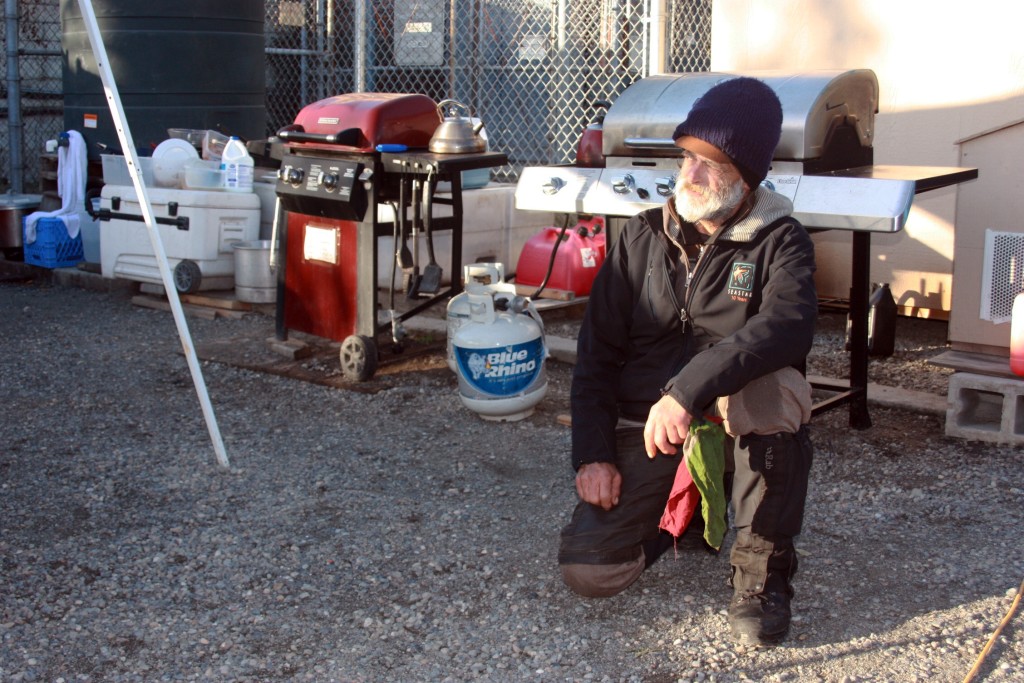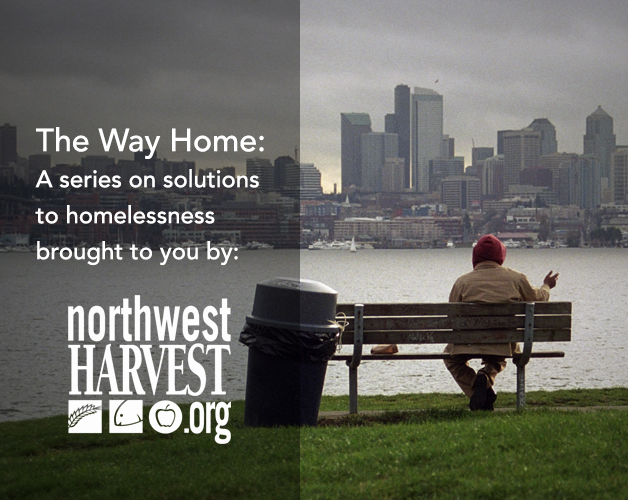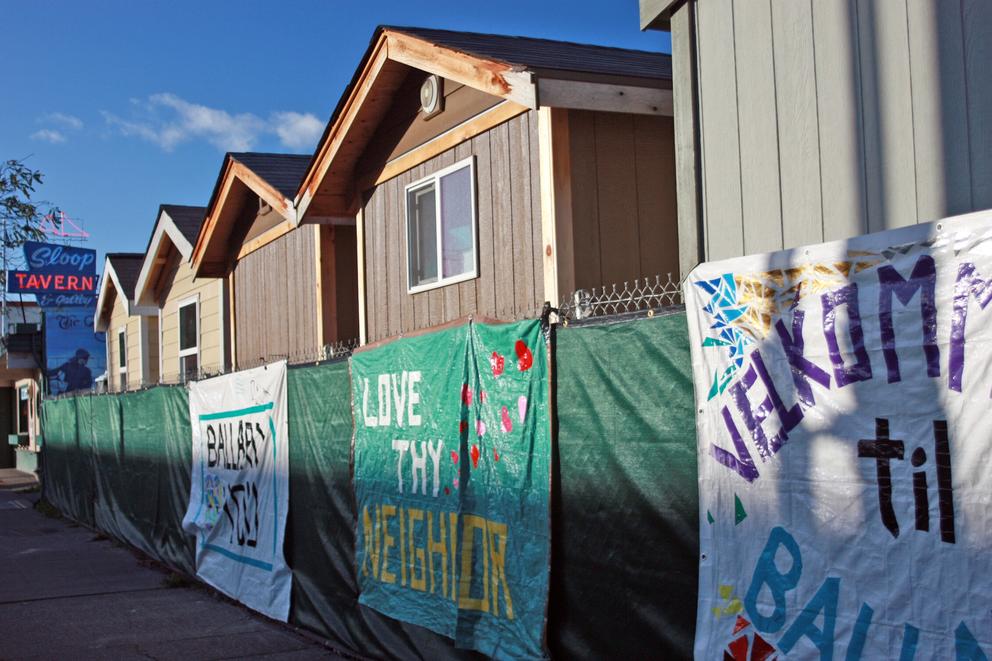When Mayor Ed Murray announced his plans to open three new homeless encampments throughout Seattle 18 months ago, the strongest opposition came out of the usually quiet neighborhood of Ballard.
The plan to build one of the camps near residences and in the middle of businesses on the west end of Ballard’s Market Street drew frustration and angry objections, including from the Ballard Chamber of Commerce. When the news was reported on “My Ballard” it garnered nearly 100 comments; reasonable voices were drowned out by the aggressive rhetoric of some commenters:
"The real brilliance … put them between a liquor store and bar! Brilliant thinking! Better yet, let’s put them right at the gateway of an historic treasure like the Locks, one of our most visited sites" wrote one commenter on My Ballard. Another compared the encampment to an episode of “The Walking Dead,” claiming the area would no doubt “go to total s$#t.”
In December, Mayor Ed Murray announced plans to authorize three new city-sanctioned encampments, with community meetings scheduled to discuss the plans this month. In contrast to the relatively affluent community near the Ballard location, the Mayor’s new spots are generally in areas with less established neighborhood groups. There's a Licton Springs location just a block off Aurora Avenue in a somewhat rundown part of Greenwood, although there is a neighborhood just to the east with a considerably higher median household income than around the Ballard property. The other two are spots in an industrial part of Georgetown with modest households incomes in the area, and along a largely undeveloped part of Myers Way South near the south city limits.
For all the doomsday drama around the Ballard encampment proposal, its first year of operation, which seems to have gone smoothly overall, suggests that encampment sites can work in a broad range of neighborhoods. But many residential areas have limited space where a camp might go, and city officials note that, even with legislation passed in early 2015 to allow temporary encampments in more areas, there are limitations in putting them in residential areas. Indeed, the Ballard encampment was always a somewhat unusual situation, since the city happened to have a vacant piece of property that was barely large enough to make some slight difference in the growing problem of homelessness. And the property could be readied for use quickly, with residents moving in just before the end of November 2015.
Ballard’s so-called Nickelsville encampment is a surprisingly colorful array of tiny houses and tents on platforms, boasting a population of 28 or so residents referred to as “Nickelodeons.” It’s a painful 30 degrees outside, and the ramshackle village, while not exactly bubbling with activity, shows signs of life. A group of residents mingles by the entrance of the camp, and an older man sits behind the open window of one of the tiny homes whose door features a wreath. A cardboard sign in the window reads “office”— a resident jokes that the cabin serves as “headquarters.”
The man behind the desk identifies himself as Will — “Well, I go by ‘Wildcat Will,’ but that’s a long story,” he says — and offers to give a tour.
The premises, which was originally supposed to hold up to 50 people, is clean and enclosed by a chain-link fence. The one-person homes are covered in thick blue tarp for heat, and a water tank and several standing barbecues are nearby. A man grills hot dogs on one while Will poses for a photo in front of another. A generator hums loudly, and Will notes that it’s shut off at 9 p.m. so as not to disturb Ballard residents, whose houses and apartments are visible on ridge overlooking the camp.

A large tent, sitting on a platform, serves as a makeshift kitchen. There’s a shelf packed with snacks and a flat screen television, which Will says was provided by the Low Income Housing Institute (LIHI). Will tells me he’s been there for a year, and while he’d like to leave, his next option for housing is $750 a month — something he can’t afford. “I’m on my final lap of life here,” he laughs, “and this is better than nothing.”
Long-time Ballard activist Jody Grage used to supply the Ballard camp with water jugs she filled with her garden hose, until the city installed a 500-gallon water tank. She says that the Ballard camp is doing “just fine,” and the relationship between the community and the camp is mostly amicable.
Grage, who is an 80-year-old retired special education teacher, says she’s seen scenarios like this play out before. “This is pretty routine when there’s a new encampment,” she says, referring to the opposition, “There’s a lot of uproar, people think the world is coming to an end ... and it doesn’t.”
To those who point fingers at the homeless for exacerbating neighborhood crime, Grage notes that the homeless themselves are significantly more vulnerable to crime than housed people. She acknowledges that bicycle theft and litter may indeed be problems, but for the most part the situation is working well.
As for criticisms that the city encampments fail to address the need for permanent housing, Grage says: “Look. The patient is bleeding to death. We’ll take Band-Aids, thank you.”
Initial controversy about homeless services followed by adjustment isn’t new in Ballard. In 2014 residents filed a legal complaint against the creation of a laundry and hygiene facility for homeless people called an Urban Rest Stop. Residents cited concern about the facility’s residential location.
Ronni Gilboa serves as the Urban Rest Stop manager for several facilities in Seattle. The rest stops, maintained by the LIHI, provide free hygiene services such as laundry, private showers and haircuts. They also have staff on-site to connect patrons with housing and additional community services. Beyond that, needle exchanges and workshops on topics such as sex ed are held.
While the Ballard rest stop faced pushback, Gilboa says it wasn’t long before residents accepted it. The rest stops serves over 8,000 patrons a year, 60 percent of whom are working poor. Gilboa, who has been working at the downtown stop since the early 2000s, notes a diverse set of patrons: “We provide services to children, to elders, to women, to youth, to babies, to vets, to immigrants and refugees.” She says that the objective of the rest stops is simple: “Basically, the people that use the rest stop need to take care of themselves. They’re going to work, they want to find a job, they have an appointment, they need to get clean. They have to be presentable.”
She notes that the rest stops faced pushback from other communities they were planning to enter. In supposedly sophisticated Downtown Seattle, it took 10 years for LIHI to open a location due to legal pushback.
“What it is is fear of the unknown,” say Gilboa, “and fear of difference.”
The reality is different than the fears. “What you’ll see is people trying to take care of themselves,” say Gilboa, “they’re making the best of a bad situation.”
City Councilmember Mike O’Brien represents District 6, which includes Ballard, Fremont and some of Greenwood. Reflecting on Nickelsville a few weeks after the encampment’s one-year anniversary, O’Brien is vague but optimistic.
“I hear from a lot of folks,” he says, “it’s not as bad as [they] thought, that it’s actually working pretty well.” He says he believes that many formerly vocal opponents, from the Ballard Chamber of Commerce to the neighboring VFW (Veterans of Foreign Wars) Hall, are now supporters. “It’s a good story that a self-managed encampment of homeless people can be a good community neighbor… It’s also great to see that individuals who were very opposed have been able to re-evaluate,” says O’Brien.
Nevertheless, O’Brien acknowledges the paradoxical nature of Seattle’s homeless issue. The city is devoting more effort to helping them — in 2015 alone, O’Brien notes that 7,000 people were moved from transitional to permanent housing — but the numbers of homeless appear to be growing. As for moving forward, O’Brien recommends low-barrier housing options, as well as investment in other services for addiction and mental illness. He says efforts for rapid rehousing and 24-hour shelters are gaining ground.
He does warn that encampments should not be implemented as suddenly as Nickelsville was. But O’Brien notes that after Mayor Murray’s recent announcement regarding the opening of more camps for this year, there was very little outrage compared to the 2015 announcement. “I think a lot of people see [the encampments] as a step in the right direction,” O’Brien concludes.
City homelessness director George Scarola said in an emailed statement that, before this round of proposals, officials made calls to community leaders to alert them of the encampment plans, and emails went to several dozen community activists living near each site.
While most of the controversy has died down among Ballardites, there are still residents who are less than thrilled about the set-up. Many continue to feel that the lack of early involvement with Murray’s decision to put a camp in Ballard is symptomatic of city disenfranchisement, in both their neighborhood and others.
I met with one of these residents, a long-time Ballard community member who lives close to the camp and didn’t want to be named because of the emotions around the issue.
When the camp was first announced, volatile voices — on both sides of the issue — masked a more pragmatic dialogue many Ballard residents were hoping to have. Many felt that questions regarding the logistics of the camp, its selection, enforcement of ordinance rules, and measuring impacts on the community went virtually unanswered.
It’s evening time as we walk past the Nickelsville camp. With the encampment housing only 25 to 30 people at any given time and a low turnover rate, unsanctioned homeless camps have sprung up around Ballard this past year. Some are occupied by those turned away from Nickelsville, or displaced individuals that hope to utilize Ballard’s other homeless services, like the Urban Rest Stop or those provided by advocacy groups at churches.
One of these unsanctioned camps is a few hundred yards away along the Ballard Locks. The camp, which is visible from the street, appears larger than Nickelsville and has been provided with a garbage can by the city. The resident says that the disposal container is rarely used, and Ballard residents will often find needles and trash spillage in the area. Social workers will visit the camp, although it doesn’t have any official authorization.
Some residents, concerned about what seems to be an evident perpetuation of homelessness throughout the year, feel that they are pegged as being “anti-homeless,” and “anti-poor.” As in the rest of the city, others worry about the reports of crime, including occasional assaults by a homeless person, they see on social media sites. They wonder if the Nickelsville camp is a destabilizing force in their neighborhood, but they feel that their hands are tied. They fear that the camp — while good for some — may be exacerbating the larger problem of homelessness in the neighborhood, and ultimately the city as a whole.
Some wonder whether facilities like Nickelsville are helping to relieve Seattle’s staggering homeless problem. Or, we might ask, has the city’s temporary solution missed the mark?
None of the next wave of encampments seems likely to provoke much political upheaval.
Former Mayor Mike McGinn tweeted a graphic a few weeks after Murray’s December 1 announcement of more camps. “Interesting relationship between location of homeless encampments and location of political donors,” McGinn wrote underneath a photo of two side-by-side maps. On the left was a map dotted with the locations of current and future encampments; on the right, a color-coded map that showed donor locations.
A quick look shows that the encampments were located far away from areas saturated with political donors.
City officials, though, point to the ordinance on where encampments can be sited and to the lack of available land in many neighborhoods, rather than any fear of more controversy.
The Ballard situation also seemed to be a case in which public officials decide to go ahead with a fairly unpopular proposal, believing both that it is the right choice and will meet larger acceptance over time.
Director of Homelessness Scarola claimed that after the initial announcement an advisory committee was formed and said that both the city and the site coordinator worked extensively with Ballard residents. "These are ongoing conversations that provide a forum for community engagement and that have led to a positive relationship over the past year," he said. "A similar model exists at the other encampments and will be built around the ones that are being opened."
Unless the problem of homelessness starts to diminish or the city comes up with a dramatically different strategy, Murray is likely to propose opening more encampments in the future. Some of the lessons from Ballard may continue to be used, but whether the city will expand the range of neighborhoods hosting such facilities is unclear.
—
This series made possible with support from Northwest Harvest. The views and opinions expressed in the media, articles, or comments on this article are those of the authors and do not reflect or represent the views and opinions held by Northwest Harvest.



